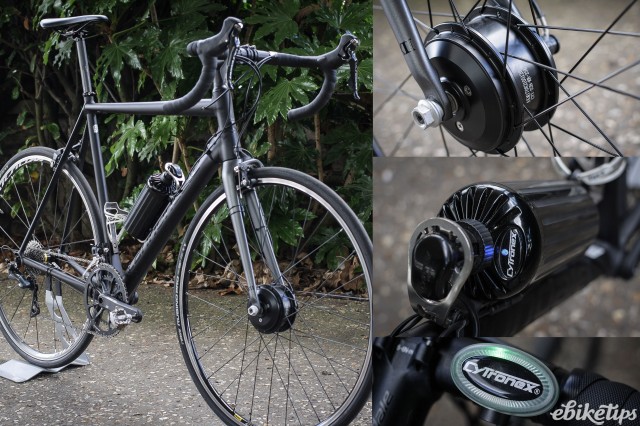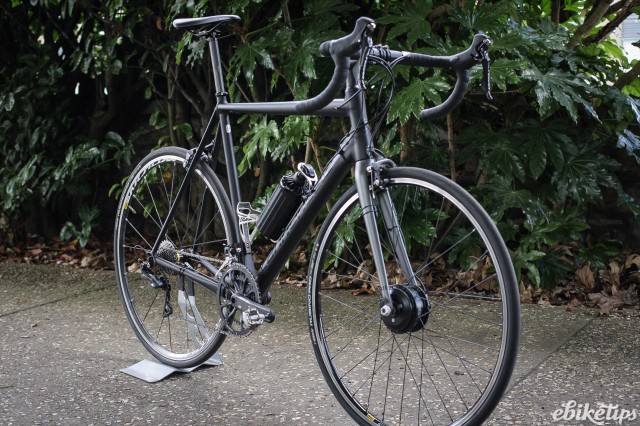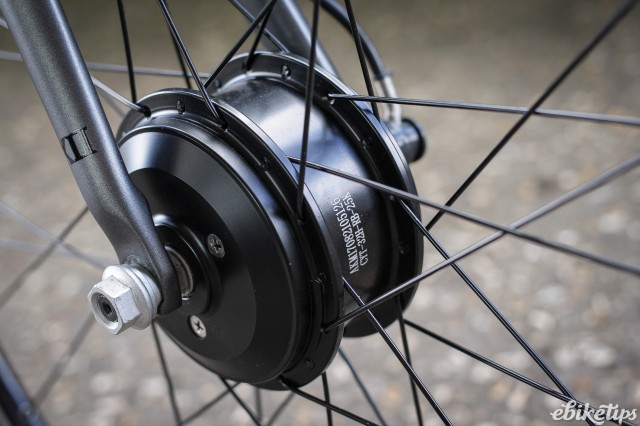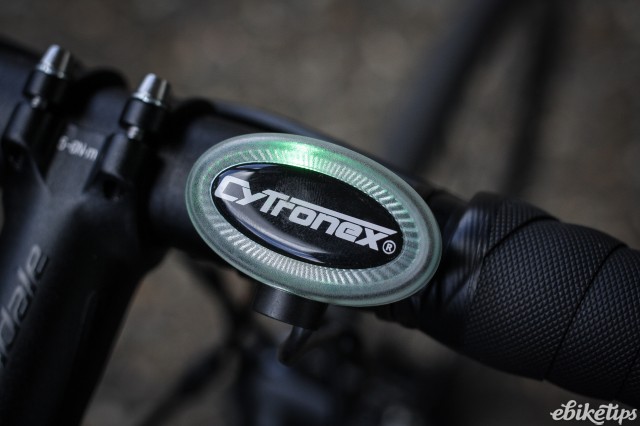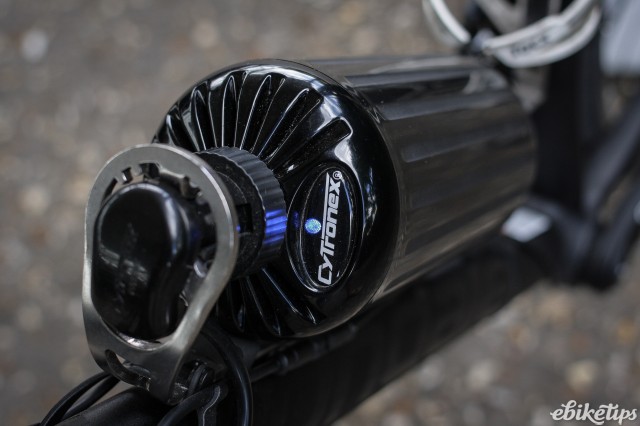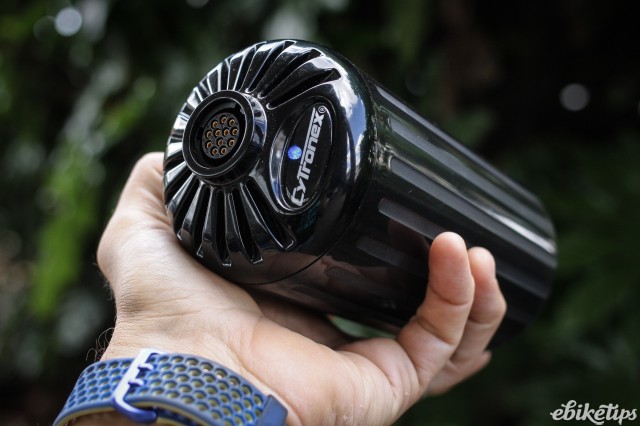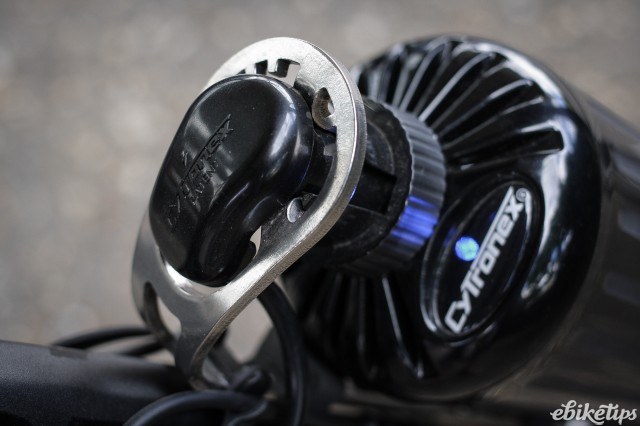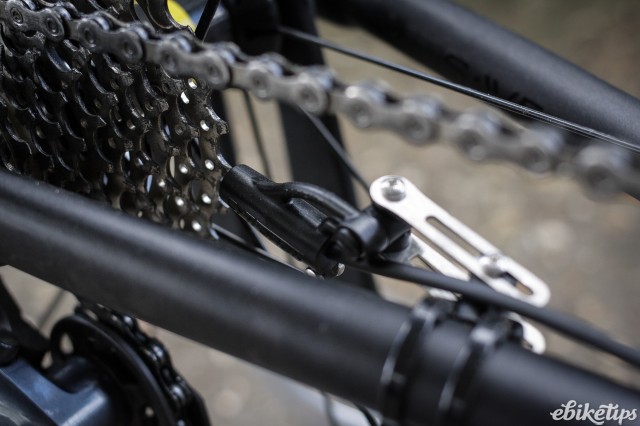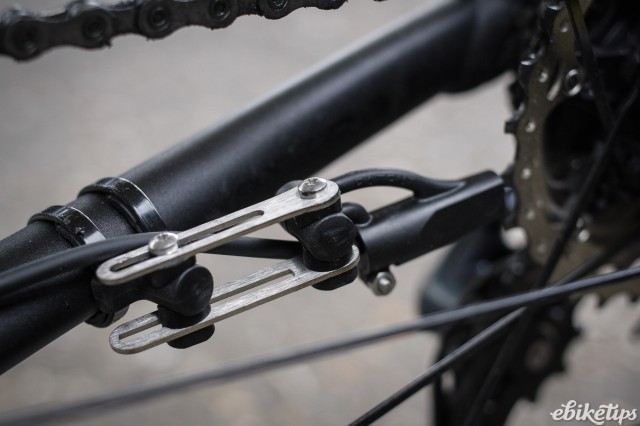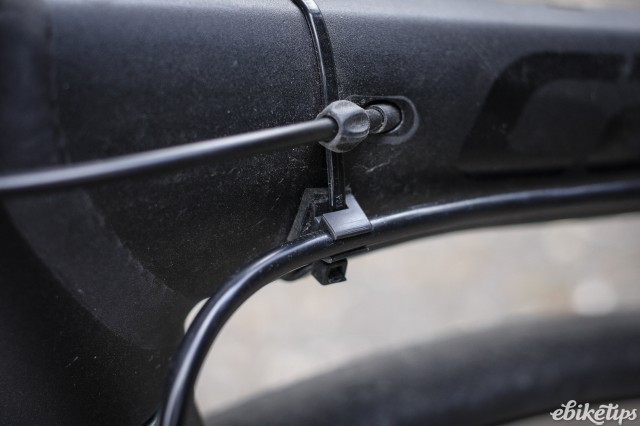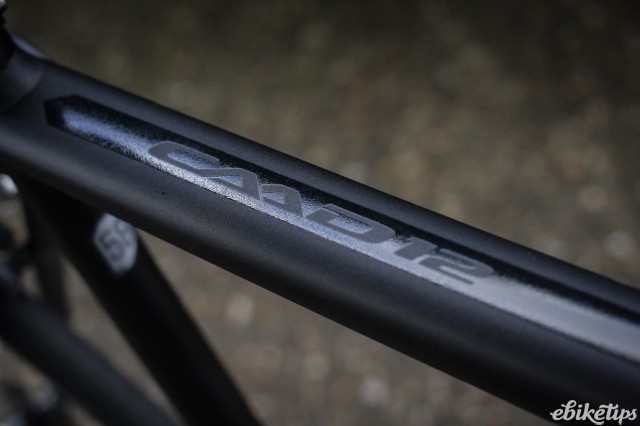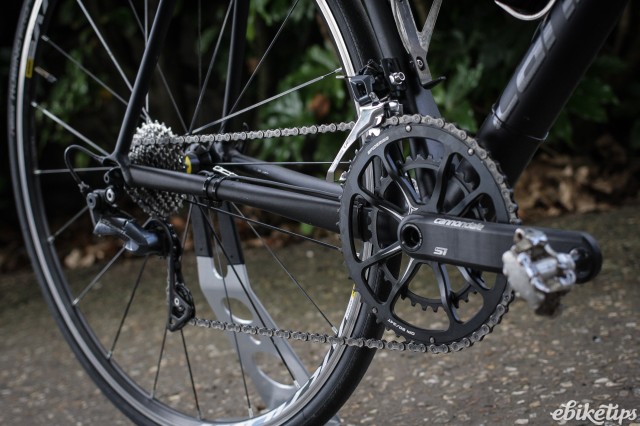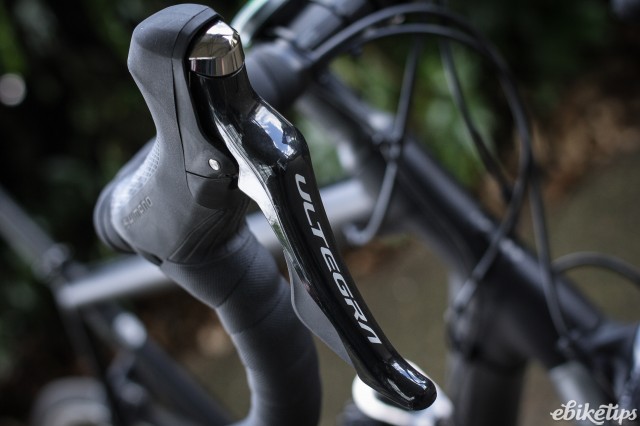Cytronex C1 system
Overview
- Low system weight
- Good range from the bottle battery
- Unobtrusive
- Front hub motor prone to understeer and slipping on loose surfaces
The e-road market has been exploding recently, with plenty of the major manufacturers now offering some kind of assisted road bike. Cytronex have been ploughing this furrow for years, though – they first offered a system in 2008 – and their lightweight and simple British-made C1 system is a serious alternative to an off-the-shelf e-road bike. You can fit it to a bike you already have, or you can buy a complete bike (or a new bike to fit it to yourself), but whichever way you’ll end up with a bike that’s seriously light with useful power on tap. It’s good value, too.
In essence the C1 isn’t anything unusual: it’s a front hub motor connected to a 180Wh bottle battery that also functions as the system’s brain. A simple controller fits to the handlebars and a single sensor is added to the chainstay. That’s it. It looks pretty simple but Cytronex has put a lot of work into the custom circuits that drive the system. The whole thing weighs a claimed 3.6kg, which makes it one of the lightest out there, comparable with ebikemotion’s 3.5kg X35 system that Orbea and Wilier use. We didn’t strip the components off the bike to weigh them, but our test bike, a 58cm Cannondale CAAD12 Ultegra, tipped the scales at 11.8kg, suggesting the claimed weight is about right; that’s about as light an e-road bike as we’ve tried thus far. Bought as a complete bike the Cannondale costs £2,895 direct from Cytronex with the motor system fitted. The system on its own is £995, and can be fitted to most standard road and city bikes.
Obviously if you’re buying the C1 system to retrofit it to a bike you already have there’ll be some spanner work involved. I can’t offer too much insight into how hard that would be, as ours came fully assembled, but there’s nothing that looks particularly scary. The hub motor is a pretty standard affair; you need to make sure you get some of the washers in the right place but it’s not complicated. The bottle battery fits to a carrier that simply attaches using the bike’s bottle bosses, and the chainstay-mounted rear sensor just requires a couple of zip ties and some fiddling to get it in the right place. There’s a bit of tidying up to do after that, but the system is very neat and not particularly obtrusive; Cytronex reckons it's about a half hour's work to fit. On a club run with about 20 riders, only around half of them noticed that it wasn’t a standard bike.
Using the system is simple enough. The controller is a single button: you click it to turn the assistance on and off, or hold it to cycle through the three assistance modes. Green, blue and red LEDs light up to let you know which mode you’re in. There’s also an LED on the battery that changes colour as the battery depletes, starting off green and progressing to blue, red and flashing red. As far as on-bike controls and displays go, that’s it. The controller is simple enough to use; it’s fairly basic but you get used to it pretty quickly.
Once you’ve charged up the battery (2.5 hours on the standard charger, 90 minutes on the more expensive rapid charger) it’s time to hit the road. Fitting the battery is simple: slide it into place and engage the collar. There’s no battery lock as standard, although one is available as a cost option. Then you’re off! Given that the bike as a whole is less than 12kg it’s no surprise that it behaves a lot like a standard road bike. There’s some extra weight there, but nothing that adversely affects the handling overmuch. This isn’t really the place to be spending too much time talking about the Cannondale CAAD12 that the C1 system was attached to, but it’s fair to say that it’s a modern classic and one of the best alloy road bikes you can buy, so I’d have no reservations about recommending it as a base bike if you’re going down the pre-built route.
One of the main selling points of lighter e-road bikes is that you don’t need to be under power the whole time: the motor is really only for assistance on the hills. This is certainly a bike that can be happily ridden with the motor switched off. On group rides and club runs I found it easy enough to keep up with everyone cruising on the flat; there’s not much resistance in the hub motor when the system is off, and the extra weight isn’t really an issue on flat or gently rolling terrain. Once things start to get a bit more lumpy, a quick punch of the button and you’re under power and off the front. Well, depending on what mode you’re in. By default the three assistance modes offer between about 80W and 250W of extra push. If you’re in top mode then people you’d normally keep pace with up a climb will certainly be left in your wake if you’re trying at all hard. But on lower modes it just means that you can ride in a group on climbs without putting so much effort in. If you find that you’re normally left behind when the road starts to rise, you can add as much assistance as you need to stay in contact: it’s a great leveller in groups of mixed ability. The motor's assistance is quiet, and the power is smoothly applied. From a standstill there's a bit of delay before the motor kicks in, but it's not bad, about a second. The sensor is actually a lot more sensitive than that, but the delay is built in: "It is a delay we impose in software for safety in case you are manoeuvring when you set off - such as doing a U-turn in the wet", Cytronex told us.
If you want to play about with the motor settings, you can use the Cytronex desktop app, which connects to the controller in the battery via USB. You can set the three assistance modes to whatever you fancy between the minimum and maximum available: currently 80W and 250W, although the next firmware update will drop the minimum assistance to 50W. Cytronex told us that its experience is that commuters tend to set the assistance levels higher, while road cyclists often don’t feel they require the full power of the motor. I’m happy to have full power there as an option, personally, even if I seldom use it; mostly I had the bike in the lower two settings, only using the maximum power mode for hard climbs or for when I was feeling particularly lazy on the ride home.
In terms of outright power the front hub motor doesn’t offer the same kind of assistance as a market-leading mid motor, but it’s decent and copes well at low speed, where you need the help the most. The fact that you’re riding a very light bike with sensible gearing helps, of course. On my benchmark hill (1.5km at 5%, maximum 12%) there was plenty enough motor power, and low enough gears, to make the climb pretty trivial. You can get up much steeper than that, too: for fun we took the Cytronex up Prospect Place, Bath’s steepest climb. It averages over 20% for 800m, and the steepest bit is nearly 30%. It’s fair to say it wasn’t a free ride up there, but it’s a whole lot easier than doing it under your own steam!
That climb did highlight some of the issues with front hub motors though. They’re prone to lose grip the steeper the road gets, as more of your body weight is over the rear of the bike, and prone to understeer for the same reason. That climb is certainly an extreme example, but those are traits you also notice on shallower climbs with loose or broken surfaces, or tight corners. On a normal road ride, it’s less likely to be an issue.
It’s interesting that Cytronex don’t offer a rear motor system, but it’s also understandable: a front wheel is usually a straight swap, where there are a much wider number of rear wheel standards to cover – axle widths, freehub bodies – and it’s hard to offer a rear hub as a fit-at-home option without keeping a lot of stock. For ready-built bikes such as our test Cannondale, though, I’d like to see them offer it as an option. The weight distribution in the bike would be better, and there are fewer issues with traction and understeer. The motor system would be even less visually noticeable, too; the Orbea Gain and Wilier Cento Hybrid, with their rear hub motors, look almost exactly like a standard road bike. It’s one for the future, and certainly something the company is considering.
Range is something that’s more difficult to measure on a bike like this than it is on a standard city bike, because it depends a lot on whether you’re using the motor system or not. On a flat ride with less fit friends you might never switch it on. My experience is that I’ve never used the motor anywhere near enough on any ride to run out of juice, and that’s on rides up to 60 or 70km. I’ve never been down in the red when I got home. The battery isn’t big at 180Wh, but it’s comparable with other lightweight systems such as the Fazua Evation, the ebikemotion X35 and the Bafang M800.
In a straight climbing test it’s not going to last as long as something like the Bianchi Impulso e-Road, with a powerful mid motor and a 500Wh battery; I managed two and a half full climbs of the commute home on full power, which is about what I’d expect given the battery size; in total that’s around half an hour of riding on full power. The Bianchi managed five, and the difference isn’t surprising given the difference in battery capacity, but neither bike struggled to complete two- and three-hour group rides, and the Cytronex-equipped Cannondale was more fun when the battery was off, mostly because it’s about 4.5kg lighter. It’s worth noting, too, that the Cytronex managed half the range of the Bianchi on straight climbing for considerably less than half the battery capacity. “If you are mainly riding up steep hills at low speed a crank drive will be best”, says Cytronex, “but if the hills are not so steep or the steep hills in your journey are shorter then we believe the efficiency of our drive (especially our electronics and software) is very high indeed.” That’s backed up by the range the C1 manages out of its small battery.
If you’re looking at a lightweight e-road bike, rather than a standard e-bike, then part of the deal is that you’re happy to do some of the work yourself. Maybe you want to be able to keep up with the young bucks at the club on the climbs, and that’s not an option now you’re past your prime. Maybe you’ve got a long commute that you want to be able to tackle more often, and an e-road bike will mean five days cycling instead of two or three. Whatever: there’s lots of cases where a bike like this will come into its own. Realistically the C1 system is most directly competing with the off-the-shelf options like the Orbea Gain and the Cube Agree C:62 Hybrid. In this build the C1-equipped Cannondale is lighter than either of those bikes and arguably a nicer ride when you’re doing it on your own. There’s not a lot to choose between them when the motor’s on, save for the fact that I prefer a rear drive motor to a front drive one.
The Cytronex System is very good, and you’re getting a lot for your money. The £2,895 list price for the Cannondale as built here is very competitive when compared with your other options, and obviously if you’re fitting the C1 system yourself you can have a fully-functioning e-road bike much cheaper than that. You can pick up a Tiagra-equipped Cannondale CAAD12 for around £900, and you’ll still end up with a full bike that’s fun to ride and weighs in at under 13kg for less than £2,000 if you’re happy to fit the system yourself. And, of course, you might already have a bike you’re happy to fit it to, saving you the whole cost of the bike. It represents good value either as a full build or as a retrofit option.
4 comments
Thanks for contacting me and for sorting the problem with overheating and replacing the faulty part. As I said in my previous comments - the system works well on our tandem and obviates the need to buy a whole bike (a significant expense; especially with a tandem). It is elegant and efficient. Incidentally, my wife has a solo bike with your system wich she has been using for several years. It is perfect for her needs and has allowed her to cycle again after a partial knee replacement.
Hi I am probably one of the first customers for the Cytronex C1 - I've had my lovely retro Bobbin fitted with the kit for a year and use it all the time for transport whether to work or to go on a cycling trip, often heavily laden with luggage or shopping. It's very hilly where I live and I would not cycle if I did not have the assistance, plus I am a lot fitter too. This article is great but I just wanted people to know that Cytronex C1 is not just for lean (male) cycling journalists on flashy road bikes, and my whole bike only cost about £1400. I am going on holiday with my husband and friends next week who are better cyclists than me so I know I can keep up and even be able to chat whilst going up those steep hills (which annoys my hubbie no end!)
Hi Albionnrt
Please can you contact us directly asap – this is most definitely not normal. We found the cause of this issue which was in a small number of bottles and thought we had covered off everyone, so sorry, we assumed we’d hear either by direct contact with us or using the diagnostics in the Cytronex App. If you get in contact with your details we can easily sort this for you. Look forward to hearing from you soon, Mark Searles
We have the system on our tandem. Works well generally but we have found that on a long climb the battery gets hot and the protection system turns it off to prevent over-heating.
